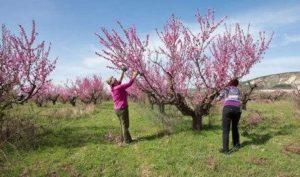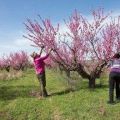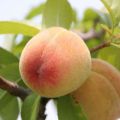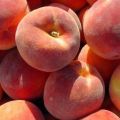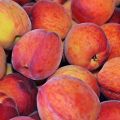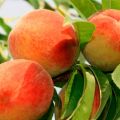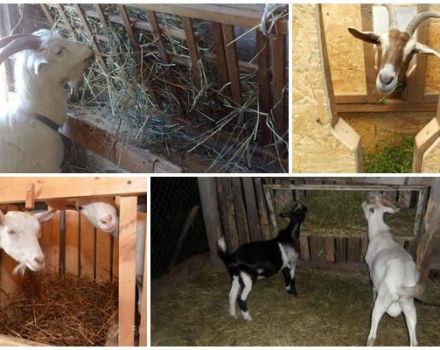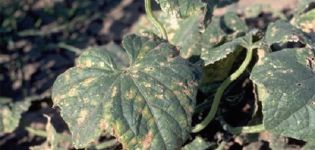Characteristics and description of the Donetsk yellow peach variety, planting and care
Peach trees are very rare in the Middle Belt. Traditionally, this crop is considered exclusively southern, and few gardeners dare to plant it if they are not completely sure about the weather conditions. In fact, among the many varieties, there are those that are suitable for northern places. In this regard, it is worth noting the Donetsk yellow peach. Despite its frost resistance, it has good taste and other advantages.
Varietal tree features
The variety got its name thanks to the Donetsk Experimental Station, where it was bred by Lilia Taranenko and other breeders in 1960. Now it is called the Bakhmutov Research Station, and the variety is still propagated at its base for planting in the south of Ukraine and Russia (in the Rostov region).
The variety has the following description:
- tall enough trees;
- the crown is dense, spherical;
- winter hardy,
- mid-season;
- begins to bear fruit 3 years after planting;
- leaves are large, lanceolate, dark green;
- the flowers are lush, deep pink and crimson.
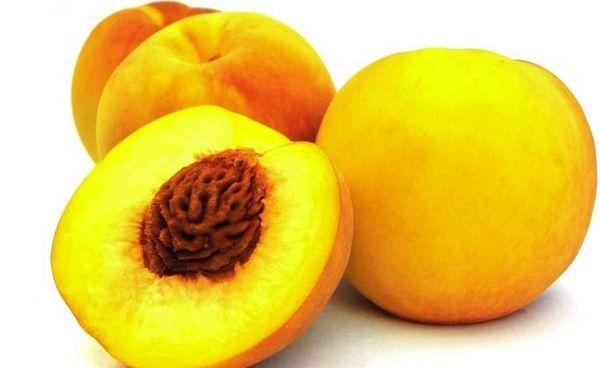
Due to its beautiful flowering, Donetsk yellow peach is often planted to decorate the garden, like other varieties of culture. The palatability of the fruit is also high:
- in size - medium or large;
- the skin is slightly pubescent, yellow, with a red spot;
- the pulp is yellow, juicy, sweet with a slight sourness and a pleasant aroma;
- suitable for use in any form.
Varieties of varieties
Donetsk peach has two types:
- yellow Donetsk;
- white Donetsk.
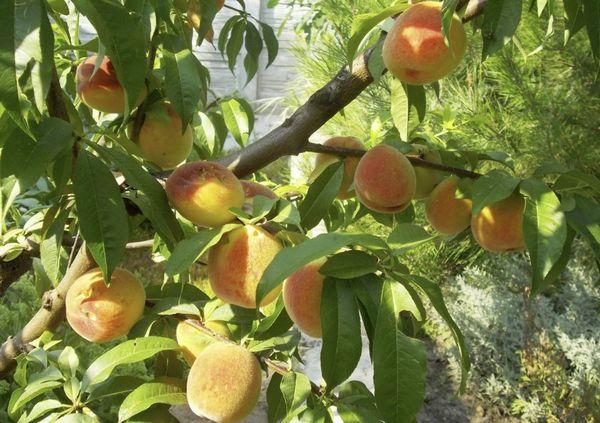
Both varieties are not very different from each other. They are frost-hardy, mid-season, give a fairly rich harvest of fruits. However, the fruits of white Donets are smaller, their maximum weight is 130 grams. The pulp is white, slightly translucent, there are prominent dark veins near the stone. Also, this variety can bear fruit later than yellow - by 4 years.
Pros and cons of Donetsk peach
This variety has a number of advantages:
- beautiful appearance;
- cold-resistant;
- even after severe cold weather and freezing, it quickly recovers;
- does not require pollinators;
- large, tasty peaches;
- up to 60 kilograms of the crop can be harvested from one tree;
- unripe fruits are easy to transport.
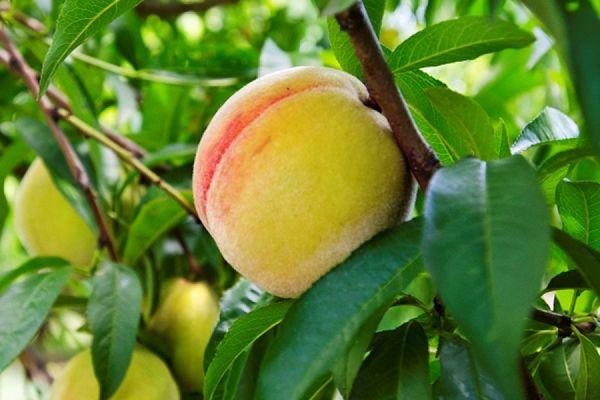
However, there are some disadvantages that can prevent you from getting a good harvest:
- poor transportability of ripe peaches;
- the variety is prone to powdery mildew and curl;
- prevention is also necessary against other diseases and pests;
- does not tolerate drought.
Also, one of the unusual features of the variety is that its fruits ripen unevenly. Each can contain both ripe and still ripening pulp.
The specifics of growing a tree
Planting Donetsk yellow peach has many features. Without their knowledge, it is difficult to achieve a bountiful harvest.
Boarding time
When choosing the time and place of disembarkation, you need to keep in mind that the Donetsk yellow peach still does not tolerate a drop in temperature to -20 degrees.
Therefore, it is suitable for regions with mild winters.

Landing dates are determined as follows:
- In cold climates, planted in spring.
- In warm places it is possible in the fall, when the temperature has already set at +10, and the sap flow has stopped.
Peach should not be pinched after strawberries, alfalfa, melons and nightshades.
Purchase of seedlings
For the tree to take root well, the seedlings must be healthy and strong:
- Root parts are not allowed to be withered or rotten.
- Greenish bark.
- The vaccination site is smooth, without damage.
- The ideal age of the seedling is 1 year.
After purchase, submerge the peach roots in growth-promoting water.
Seat preparation
Planting technology directly depends on the season. For spring, the seat is prepared in the fall:
- Dig a hole half a meter deep and 70 centimeters wide.
- Fasten the support in the middle.
- Mix the removed soil layer with 7 kilograms of humus, rotted manure or compost, also add 300 grams of ash and 50 grams of potassium chloride and superphosphate each.
- Pour the whole mixture in the form of a mound into the pit.

If the soil is fertile enough, organic matter can be excluded. The same applies to planting in the fall. In this case, the pit is dug up 2-3 weeks before the expected date and fertilized.
Disembarkation scheme and process
Planting peach seedlings does not require complex activities. It is carried out using the following technology:
- Place the seedling on a mound of soil and fertilizer, distribute the roots evenly.
- Cover with earth, make sure that the vaccination site is outside.
- Tamp, while making a small ditch around the perimeter of the pit.
- Drizzle with 30 liters of water.
- When the water is absorbed, tie the tree to a support.
- Cover with a layer of manure 10 centimeters thick. However, the fertilizer should not touch the plant itself.
Crop Care Tips
Donetsk yellow peach cannot be called unpretentious. It requires regular maintenance, and it also needs to be prepared for wintering.
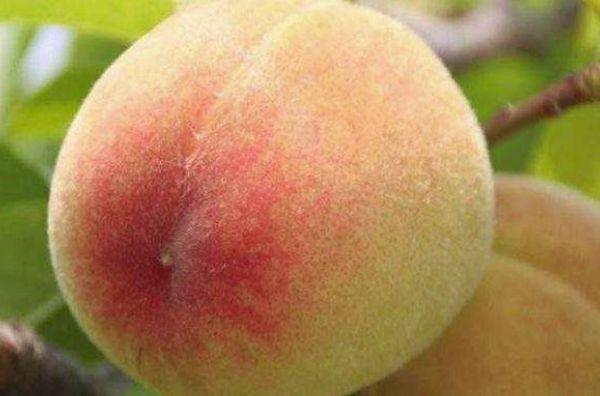
Watering mode
When watering, they are guided by the age of the peach, as well as the degree of drying of the earth. For a month after planting, water the seedlings every 3 days, volume - 1 bucket of water. In dry weather, do this more often - once every 2 days, you can pour out 2 buckets already. Already adult peaches need 5 buckets, but if there was a lot of precipitation in winter and spring, then they do not do it right away. If not enough - from May. Watering should be done no more than 2 times every 30 days.
The last watering is a month before the harvest. Also, the plant needs water before wintering. Then they pour up to 10 liters per 1 square meter.
Top dressing and fertilizers
Once every 2-3 years, a peach is fertilized with compost or humus. As for seasonal dressings, the first time a peach is fertilized in the spring. For this, diluted urea (before kidney opening) or urea and ammonium nitrate (after opening) are used.
In summer, when the fruits are forming and ripening, you can use a mixture of urea, water extract of superphosphate, potassium sulfide, ammonium sulfate and borax. They are bred in 10 liters of water. Preparing for winter also requires feeding. 40 grams of superphosphate and 50 grams of potassium chloride are added per 1 square meter.

Pruning features
There are two types of crop pruning:
- For removing old, diseased or frostbitten branches.
- Forming - after the buds have appeared, pruning is carried out to form a cup-shaped crown. Needed in the first 4 years.
Wintering specifics
After watering, digging and feeding, the soil is mulched with peat or humus, their layer should be 10-15 centimeters. Also, peaches are insulated with a frame made of cardboard or other material (bag, spruce branches), it is fixed on special pegs. If the winter is warm, it is enough to sketch out the earth so that it covers the trunk by half a meter.
Peach diseases and pests
Most often, the plant is affected by curly leaves and powdery mildew. In both cases, the affected parts of the plant are cut off. To prevent powdery mildew after flowering, seedlings are treated with Topsin or Topaz. Bordeaux liquid will help against curl; it is used in the fall.
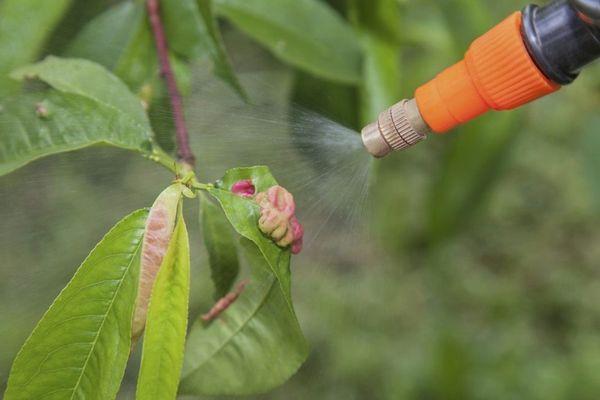
Of the pests for peaches, aphids are dangerous. In case of severe damage, the plants are sprayed with appropriate preparations (for example, Karbofos). This should be done no later than 15 days before harvest. To combat aphids and other pests after swelling of the buds, insecticides are used. After flowering, the treatment is repeated, but already together with antifungal agents.
Harvesting and storage
For storage, unripe fruits are harvested; if you use it immediately, you can take ripe immediately. If the peaches are unripe, but healthy and intact, they retain their quality for up to one and a half months. They need to be wrapped in newspapers, put in boxes and left in a room with high humidity and a temperature of 0 degrees.

